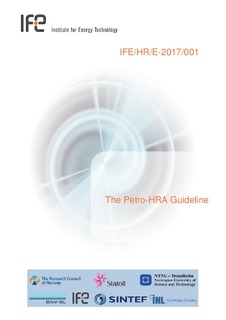| dc.contributor.author | Bye, Andreas | |
| dc.contributor.author | Laumann, Karin | |
| dc.contributor.author | Taylor, Claire | |
| dc.contributor.author | Rasmussen, Martin | |
| dc.contributor.author | Øie, Sondre | |
| dc.contributor.author | van de Merwe, Koen | |
| dc.contributor.author | Øien, Knut | |
| dc.contributor.author | Boring, Ronald | |
| dc.contributor.author | Paltrinieri, Nicola | |
| dc.contributor.author | Wærø, Irene | |
| dc.contributor.author | Massaiu, Salvatore | |
| dc.contributor.author | Gould, Kristian | |
| dc.date.accessioned | 2017-05-12T09:56:05Z | |
| dc.date.available | 2017-05-12T09:56:05Z | |
| dc.date.created | 2017-02-13T15:54:39Z | |
| dc.date.issued | 2017 | |
| dc.identifier.isbn | 978-82-7017-901-5 | |
| dc.identifier.uri | http://hdl.handle.net/11250/2442387 | |
| dc.description.abstract | The Petro-HRA method has been developed in an R&D project called “Analysis of human actions as barriers in major accidents in the petroleum industry, applicability of human reliability analysis methods”, Project no. 220824/E30. Petro-HRA is a method for qualitative and quantitative assessment of human reliability in the oil and gas industry. The method allows systematic identification, modelling and assessment of tasks that affect major accident risk. The method is mainly intended for use within a quantitative risk analysis (QRA) framework, but may also be used as a stand-alone analysis. Petro-HRA should be used to estimate the likelihood of human failure events (HFEs) in post-initiating event scenarios. | nb_NO |
| dc.language.iso | eng | nb_NO |
| dc.publisher | Institutt for energiteknikk | nb_NO |
| dc.relation.uri | https://www.ife.no/en/ife/departments/industrial_psychology/projects/petro-hra/files/the-petro-hra-guideline | |
| dc.title | The Petro-HRA Guideline | nb_NO |
| dc.type | Research report | nb_NO |
| dc.source.pagenumber | 237 | nb_NO |
| dc.identifier.cristin | 1450091 | |
| dc.relation.project | Norges forskningsråd: 220824 | nb_NO |
| cristin.unitcode | 7492,5,1,0 | |
| cristin.unitname | Industripsykologi | |
| cristin.ispublished | true | |
| cristin.fulltext | original | |
